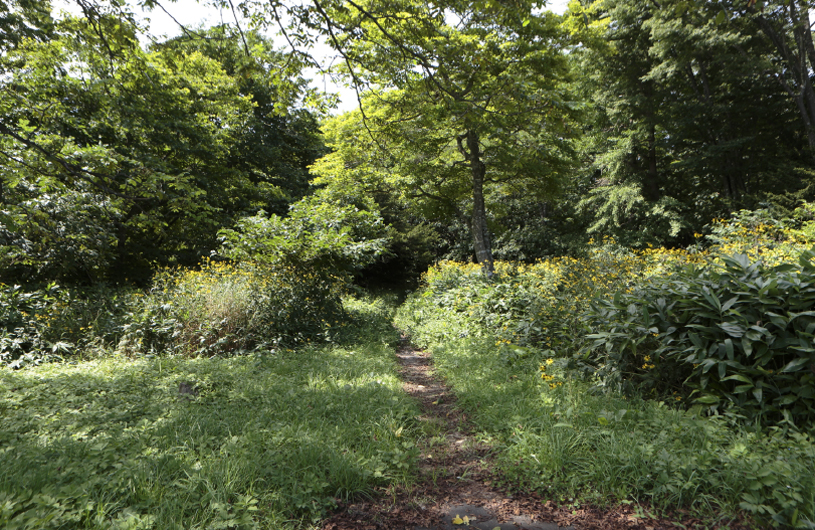
Just along this road is where the office of the Tokugawa Farm once stood.

Just along this road is where the office of the Tokugawa Farm once stood.
Calm sea, lush mountain forests, wide-open plains, rivers to where the salmon return. "From here, the reconnaissance team of the Owari branch of the Tokugawa Clan's former vassal saw the view, which determined the move to Yurappu (currently the town of Yakumo)." Tsuneo Komura of the Town-walking-guide Yakumo Storytellers Association first took me to Tokotan Hill. Overlooking the downtown area, the hill provides a real feel of the vastness of Tokugawa Farm. Ancestors who developed the land are laid to rest in Daishin Cemetery on the hilltop. In their final hours, perhaps they remembered their hometowns. The fact that the gravestones face in the direction of Owari is somewhat heart rendering.
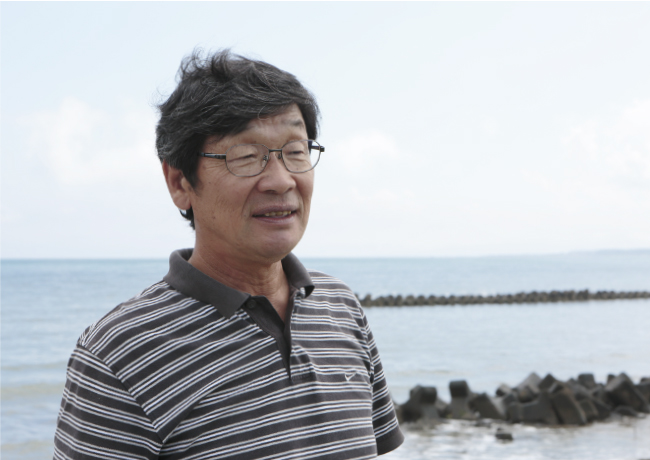
Mr. Komura is second to none when it comes to talking about Yakumo's history
The Tokugawa Clan proposed that the government gave them approximately 4.96 km² of land in exchange for the clan bearing the cost of development. This en-masse move by the Tokugawa Clan pioneered the way for privately funded, organized development in Hokkaido, and was subsequently used as the model for the transfer of former warrior classes to other areas, such as the Mouri Clan (Yoichi), Maeda Clan (Iwanai), Nabeshima Clan (Ishikari) and the like.
From 1878, pioneers landed at the estuary of the Yurappu River, up which the salmon return. "There was an Ainu kotan of about 35 households here, along with about 13 wajin homes, travelers' lodgings, a ferry quay and fishing businesses that employed Ainu. The road that stretched straight up from the quay is now this Hama-dori (Hama Street). A year after the former warrior classes landed here, a government-funded road was built to intersect with it; at the time it headed in the direction of the farm but now it leads to the town hall. What's more, this is the road that was built between the Ainu kotan and the area in which the wajin lived."
Thanks to these words, the landscape I saw was transformed.
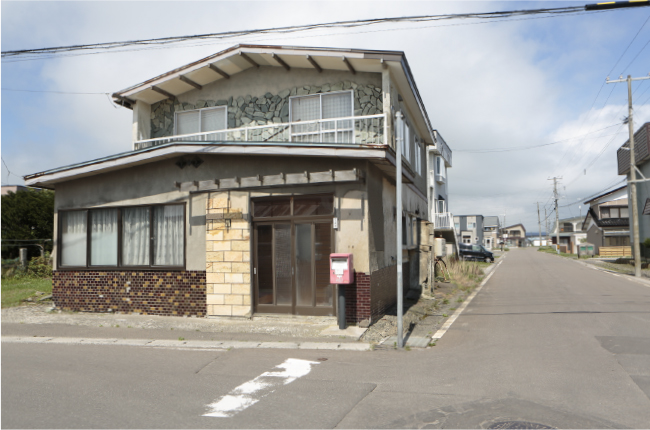
The view of the Takeuchi residence from the intersection of Hama-dori (Hama Street) – which was created as the cargo was being hauled from the quay – and the area where the Ainu kotan once stood.
The site where the offices of Tokugawa Farm once stood has a mysterious feel to it. The colonies of Giant Heartleaf Lilies (Cardiocrinum cordatum var. glehnii), which are precious to the Ainu, are evidence of the fertility of the land. The bark of the cedar tree is finely featured like a sculpture. "Around here, the vegetation of the development period remains as it was at the time. Next to here is a reception hall and there was a boat floating on the pond." Mr. Komura points to a concrete relic. "This is the remains of the cage for the bear they kept as the model for the wooden bear carvings." It was as if the historical facts I learned at the Bear Woodcarving Museum were being reproduced for real before my eyes.
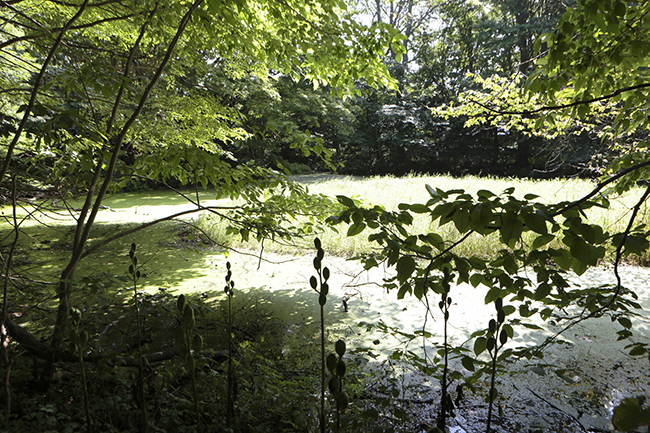
The pond at the site of the former farm office
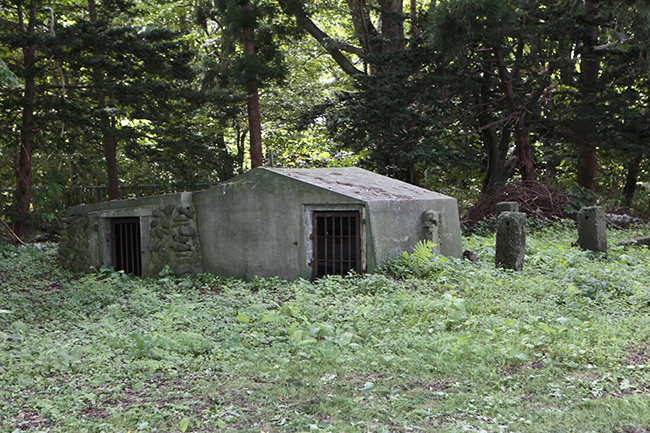
Remains of a bear cage – almost like a pillbox
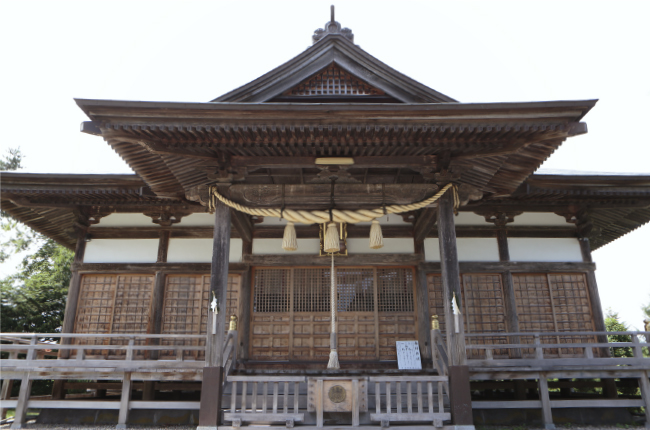
Yakumo Shrine, in its present location after being moved due to the construction of an army airfield in 1943
I thought wild Steller‘s sea eagles and white-tailed eagles could only be seen in northern Hokkaido, on the Okhotsk coast and in Shiretoko. According to Kazuo Tazawa, a Storytellers Association member who has continuously photographed wild birds locally, Salmon begin to return up the Yurappu River in early to mid September, and Steller‘s sea eagles and white-tailed eagles fly in to the region around December to prey on the female salmon and trout that have finished laying their eggs. "They can often be seen in the Yurappu River estuary, upstream around the intersection of National Highway Route 277 and Prefectural Highway Route 42, and at Keitan Bridge where the Seiyobetsu Hatchery is located," said Mr. Tazawa, generously revealing the observation points.
Swans
In autumn they fly in from the north like messengers of winter, staying until February
Steller's sea eagle
The birds can reach up to 2.5 m wide with their wings spread; dark brown in color with white shoulders and tail, and an orange-yellow beak
White-tailed eagle
Entirely brown except for the white tail, the bird waits for the Steller's sea eagle to finish feeding on the salmon
Crested kingfisher
Often seen in early winter, as well as in early spring targeting the salmon fry
Common kingfisher Also known as the "blue jewel," the common kingfisher can be seen from spring through summer
Gray heron
The largest heron to breed in Japan; can be seen quite often
Mandarin duck
The beautifully colored feathers are conspicuous on the Yurappu River
Osprey
In summer, the sight of them hunting above the shore near the estuary is beautiful; also known as the "Fish hawk"
Known by the Ainu as cip-ta-cikap (the bird that carves boats), they were worshiped as gods that warned of the whereabouts of bears (March 21th, 2012)
There are currently five volunteer guides who accompany walking tours around the town, tailored to the user's wishes. Contents include Yakumo's history, bear carvings around the town, Steller's sea eagle and white-tailed eagle watching, tree and flower tours, and tours of the town's gourmet and souvenir spots. Reservations are required for groups of up to 10 people.
Tel.: 0137-65-6100 (Yakumo Town's Information Exchange & Local Products Center "Oka no Eki")